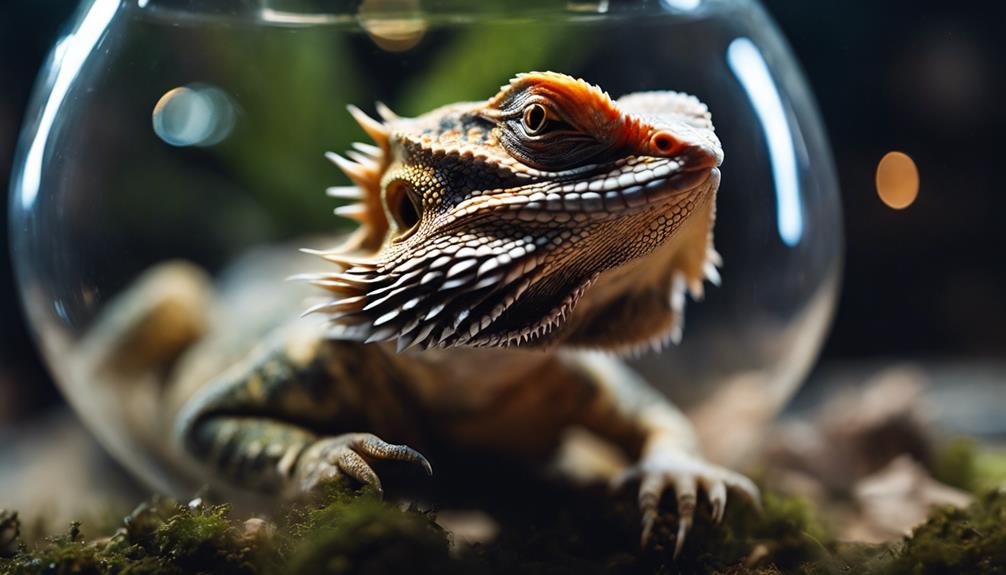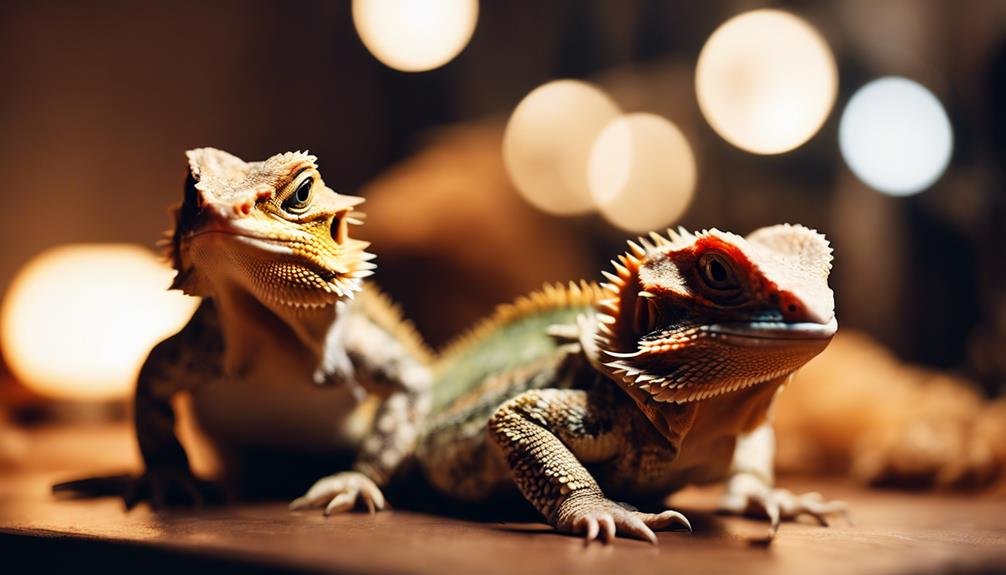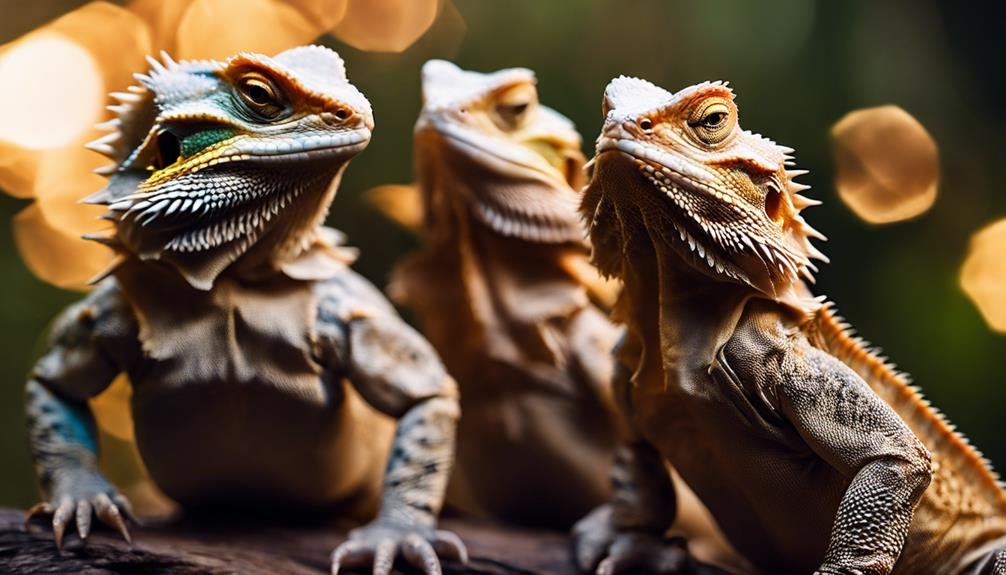You might wonder if your bearded dragon experiences emotions like happiness, sadness, or stress. It's important to recognize these signs for their well-being. When your bearded dragon shows relaxed body language or engages more with you, they're likely feeling content. However, a lack of appetite or decreased activity could suggest they're not feeling their best. Identifying stress is equally significant; behaviors such as black bearding signal it's time to assess their environment. By understanding these emotional cues, you're on the path to ensuring a happier, healthier life for your scaled companion. But how exactly can you enhance their emotional well-being? Let's explore further.
Key Takeaways
- Bearded dragons can express a range of emotions, including happiness, sadness, and stress.
- Signs of happiness include relaxed body language, enthusiastic exploration, and social behaviors.
- Sadness in bearded dragons may manifest as decreased activity, loss of appetite, and increased hiding.
- Stress indicators include black bearding, color changes, loss of appetite, and unusual behavior.
- Enhancing their emotional well-being involves providing a secure habitat, regular interaction, and recognizing distress cues promptly.
Understanding Bearded Dragon Emotions
To truly connect with your bearded dragon, it's important to grasp the range of emotions they can express, from happiness to stress. Recognizing when your beardie feels scared is a vital aspect of understanding their emotional world. Changes in their environment, such as a move to a new tank or the loss of a familiar person, can deeply impact their sense of security, leading to signs of fear and anxiety. These creatures may not communicate like we do, but they certainly show their feelings through their behaviors.
When a bearded dragon is scared, it might try to hide or show signs of wanting to escape. You'll see it in the way they might press themselves against their enclosure, seeking refuge in a corner or under decor items. It's your cue to assess what's bothering them and make the necessary adjustments to their surroundings. Providing a secure and stimulating environment plays a key role in alleviating their stress and promoting happiness. Understanding these signs of emotional distress is essential for their well-being, requiring your attention and support to make sure they feel safe and content.
Signs of Happiness
Understanding how your bearded dragon shows happiness is key to ensuring they're thriving in their environment. When your pet is content, you'll notice relaxed body language, which is a clear indicator they feel safe and at ease. This includes a calm, enthusiastic posture, often seen when they're basking under the heat lamp or lounging comfortably in their habitat. A happy bearded dragon might also display brighter colors, with their beard and body taking on a more vibrant hue, signaling their content state.
Active exploration is another sign of happiness. If they're eagerly roaming around, investigating every corner of their enclosure, it shows they're engaged and curious about their surroundings. This behavior, coupled with a keen interest in food, eating avidly when offered, is a positive sign.
You'll also notice social behaviors indicating their happiness. A content bearded dragon may engage in gentle head bobbing, interact with you by showing curiosity, and even approach you willingly, indicating trust and comfort with your presence. Accepting gentle handling without signs of distress further reinforces their happy state. These behaviors are telltale signs your bearded dragon feels happy and secure in their environment.
Recognizing Sadness


While it's gratifying to see signs of happiness in your bearded dragon, it's equally important to recognize when they're feeling sad. Sadness in bearded dragons can manifest through several behaviors which are critical to notice for their well-being. If you see your pet showing decreased activity, not exploring their enclosure as usual, or losing interest in their food, these can be signs they're sad. Similarly, if they're hiding more than usual, it could indicate they're not feeling their best.
Changes in their environment, diet, or temperature can trigger these feelings. If you've recently moved their tank, changed their diet, or if the temperature in their enclosure isn't ideal, these could be reasons behind their sadness. Additionally, a lack of interaction, proper care, or stimulation can contribute to their low mood.
Paying attention to their body language and any shifts in their behavior or appetite is crucial to recognizing when they're sad. It's vital to provide a secure, enriched environment for them and seek veterinary advice if their sadness persists. Addressing these issues promptly can help ensure your bearded dragon's happiness and health.
Identifying Stress Indicators
Just like humans, bearded dragons exhibit obvious signs of stress that you'll need to identify to guarantee their well-being. Recognizing these signs is essential to make sure your beardie lives a healthy and stress-free life.
Here are the key indicators you should be on the lookout for:
- Black Bearding and Color Changes: Stress can cause your bearded dragon to display a black beard or change its color to darker shades or paleness. This is a clear signal that something is amiss.
- Loss of Appetite and Hiding Behavior: When stressed, a beardie might eat less or hide more than usual. These behaviors indicate discomfort and the need for attention.
- Aggressive or Unusual Behavior: If your bearded dragon becomes aggressive towards others or exhibits rapid breathing, lethargy, or unusual body language, it's likely feeling stressed.
- Excessive Basking or Vocalizations: While some basking is normal, excessive basking or hearing unusual vocalizations from your dragon could be signs of stress.
Enhancing Emotional Well-being


To enhance your bearded dragon's emotional well-being, it's vital to provide a secure and engaging habitat. A stimulating environment not only keeps them physically active but also supports their mental health. Incorporating enrichment items like climbing branches and caves can greatly alleviate signs of depression and boredom, making them feel more at home in their enclosure.
Regular interaction plays a pivotal role in their emotional state. Spending time with your bearded dragon helps them feel secure and comfortable with your presence. It's not just about physical care but also establishing a bond that positively impacts their overall mood and health. Proper handling, care, and attentive monitoring are key to ensuring they're not just surviving but thriving.
Being attuned to their needs means recognizing signs of distress or discomfort early on. This proactive approach allows you to address any issues before they escalate, ensuring your bearded dragon's environment remains a haven of well-being. Remember, a happy bearded dragon is one that enjoys regular interaction, a stimulating habitat, and attentive care from their human companion.
Do Bearded Dragons Shed When They Are Feeling Happy, Sad, or Stressed?
Bearded dragons shed their skin as part of their growth process and to remove old, damaged skin. This shedding occurs periodically throughout their lives, and it is a normal and natural process. It is not directly related to their emotional state, such as feeling happy, sad, or stressed. When bearded dragons shed, they simply need time and space to complete this natural process.
Frequently Asked Questions
Do Bearded Dragons Have Emotions?
Yes, bearded dragons do have emotions. They can express happiness, sadness, and stress through various behaviors. Your bearded dragon might show its emotional state by how it interacts with you or its environment.
Changes in their routine or surroundings can affect their mood, so it's important to keep an eye on signs like appetite loss or hiding. Creating a comfortable and engaging home for them supports their emotional health.
How Do I Know if My Bearded Dragon Is Sad?
If you're worried your bearded dragon is sad, watch their behavior closely. They might hide more, show less interest in food, or move less than usual. Droopy eyes, weight loss, and a darker beard are all signs they're not feeling great.
Changes like sudden aggression or unusual lethargy are red flags too. Keeping an eye on their eating habits and overall activity can give you clues about their mood.
How Do Bearded Dragons Act When Stressed?
When your bearded dragon is stressed, you'll notice specific stress signals. They might darken their beard or body, show rapid head bobbing, or whip their tail aggressively. Their appetite could drop, refusing food more often than usual. They might also seek hiding places or try to escape when you handle them.
These behaviors are vital signs of stress, often triggered by environmental issues like improper temperature, lighting, or overcrowding.
What Is the Mood of a Bearded Dragon?
A bearded dragon's mood can vary based on several factors, including temperature influence.
If their habitat's too hot or too cold, they might become stressed or uncomfortable, showing they're not in the best of spirits.
You'll want to keep an eye on their behavior and body language for signs of happiness or distress.
Ensuring their environment is just right plays an essential role in maintaining their good mood and overall well-being.
Conclusion
To summarize, your bearded dragon indeed experiences a range of emotions, from happiness to sadness and stress. By recognizing these signs, you can guarantee their well-being.
Keep an eye out for relaxed postures and brighter colors for happiness, while decreased activity may indicate sadness. Stress shows up as black bearding and aggression.
Enhance their emotional health by creating a safe space, providing enrichment, and building a bond through regular interaction. You're key to a happy, healthy dragon.


